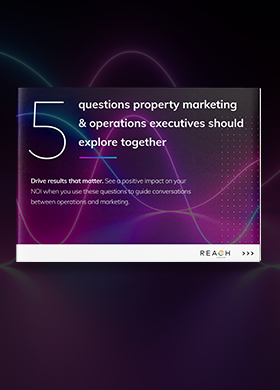Are you ready to drive results that matter? Property marketing spend can significantly impact NOI — in a positive way — but only if you know what questions to ask your marketing team. It used to be hard to see and understand property marketing results. Marketers had a hard enough time tracking which leads came from where, let alone which sources brought in leases. ILS and lead journey data was incomplete, and it could be hard to tell which budget items resulted in returns. If you were outside of marketing, perhaps working in operations or another adjacent department, understanding marketing spend could be even trickier. Fortunately, with better technology comes better data. Today, it’s easy to see exactly where a lead first became aware of your brand and at what point they converted. It’s also easy to see how much you’re spending per lead and lease. In fact, you can calculate how much you’re getting back for every $1 of advertising budget spent (keep reading to find out how). When you’re looking to guide your marketing team and help drive results that matter, here are five questions you should ask. 1. What is our current marketing mix, and is there data to support it? Marketers should know how the marketing budget is organized and why. Your corporate and regional marketing strategy should be based on historical conversion data and — if including a new technique or source — industry research and case study data. Marketing sources should include a balance of traditional ILS advertising and director-to-renter marketing. ILS marketing is critical for the awareness phase of the renter journey, but it doesn’t also get you the most qualified leads. Director-to-renter marketing, such as SEO and PPC advertising, sends renters directly to your websites where...
Future of Leads + Leasing...
Executive insight from Yardi
How has the pandemic permanently altered multifamily housing? This is one of the many questions explored during the 2020 National Apartment Association APTvirtual conference. The event hosted 63 breakout sessions and five TED-style Game Changer sessions that helped participants tackle tough questions. The Connect with Execs session offered a unique opportunity for guests to talk to Anant Yardi, founder and president of Yardi. Together, participants explored technologies that surged during the pandemic and are now industry standards. “The pandemic has accelerated the transition of digital media and the use of digital media,” observed Mr. Yardi. “AI is such an important topic. AI, big data and IoT are three topics that are taking a lot of attention.” He continued, “These are the technologies that are coming to the forefront. This is what we mean by innovation, bringing tech to the market for the benefit of the industry.” Artificial intelligence and apartment chatbots, our new coworkers Technologies that leverage artificial intelligence, such as chatbots, bridge the gap between live customer service and cost efficiency. Chatbots permit leasing agents to focus on high-value tasks instead of repetitive inquiries. When leasing agents are not available, chatbots offer a natural supplement to their services. RentCafe Chat IQ can guide prospects through the leasing journey by readily presenting information on pricing and availability, tour scheduling, pet policies and more. It communicates via chat and text and will soon have capabilities for emails, calls and in-app messages. Chatbot interactions are natural, intelligent and accurate. The engine has learned, for example, that “What r ur business hours” is actually the question “What are your business hours?” It uses natural language processing to understand typos and improper grammar. Machine learning enables AI engines to adapt to human speech and writing patterns. With each...
Mapping the Future
Of Digital Real Estate
With the excitement of spring and summer holidays ahead, most of us have in mind that the key to a great vacation is careful planning, research and a clear idea of where you want to go. Lifting a real estate company out of individual spreadsheets and into collaborative systems is a very different kind of adventure, but mapping out the steps in the process and knowing what results you need are no less critical to having a successful experience. Going Digital Without Hiring Engineers Many real estate companies in Asia Pacific, and elsewhere globally, are starting their journey toward mining the data from their team activities and customer experience with systems that look much the same as what they had been using in the 1990s. This can put property firms at a disadvantage as they expand into new markets or try to ramp up growth. With online analytics now common in finance, ecommerce and other firms, more real estate companies are looking for ways to get accurate, real time data on their businesses, but get put off by the challenge of adopting new systems, Bernie Devine, regional director for Asia at Yardi, explains. “Our message for them is that the benefits are worth the pain, and there really isn’t that much pain anymore.” Devine indicates that that while systems like Yardi’s, which allow real estate firms to manage their leasing, track building maintenance and link their financial reporting directly to the front end of their businesses, are built by teams of programmers, implementing them does not require technical knowledge. “The key to getting your business online is having a clear understanding of how each step of each process works and being able to map those steps out,” Devine said. After having helped scores of...
Student Housing
Update from Rick Graf, Pinnacle CEO
The student housing sector is not the industry’s Sleeping Beauty anymore. The number of students attending universities is growing and this is due mostly to the ease of obtaining loans. As a consequence, the demand for this type of accommodation is surging, which makes the segment appealing to investors. Sales volume almost quadrupled in the last six years, according to Rick Graf, president & CEO of Pinnacle, a Yardi client. According to Yardi Matrix data, Pinnacle Living owns and manages more than 150,000 units of which roughly 18,000 beds at 34 universities across the country, from San Diego to Syracuse, N.Y. In an interview with Multi-Housing News, Graf shares his view on the student housing industry, but also touches on what it takes for a property management company to stay ahead of the game in 2019. Tell us about your view of the multifamily market in general and the student housing sector in particular. What are the main trends? Graf: In general, the multifamily market remains robust. Demand has not lessened due to very strong job growth in nearly every market. With respect to the student housing sector, we continue to see institutional acceptance and desire to expand holdings into this niche subset of multifamily real estate. Transaction volume in student housing topped $11 billion in 2018, up from $3 billion just six years ago. It is important to note that student housing is significantly more management intensive and multifamily investors should be cautious to partner with operators with specific expertise in the nuances needed for success. Could you single out one trend that is gaining popularity in the student housing property management sector? Graf: A sea change has come to student development. While student housing properties rival high-end multifamily properties, the arms race of amenities has turned from wave...
Akshai Rao
Yardi Leadership Spotlight
Akshai Rao’s path to Yardi wound from Austin, Texas, where the vice president of Procure to Pay earned his bachelor’s degree before taking a job in Northern California. He then went to Michigan for business school and Boston for another job before landing back in Austin as a Yardi employee in 2013. Today Rao oversees client services for Yardi Procure to Pay, an end-to-end procurement, vendor management and electronic invoicing platform. He shared highlights of the platform with us in a recent interview. Q: What matters most to property managers who deal with goods and services procurement? A: They want to perform their back office tasks, especially procurement and accounts payable, more efficiently. That lets them spend more time on front office duties, such as building compliance and customer services. Q: Can you describe how the elements of Yardi Procure to Pay meet those priorities? A: We provide one platform for the entire procure to pay process—approval workflows for purchase orders and invoices that are consistent with the client’s process, plus online purchasing, vendor management, outsourced invoice management and vendor payment services. All of these processes are accessible in real time and built into the Yardi Voyager® property management and accounting platform. Yardi has documented client savings of up to 80% on per-invoice costs and 75% on per-invoice processing time. A single connected procurement solution makes day-to-day purchasing, payment and vendor management as simple as possible. In addition, we’re building a robust analytics package to help clients pinpoint areas in which they can make process improvements. We can compare our clients’ processes to industry benchmarks, and make recommendations to improve their current processes. Yardi Bill Pay, which is part of both Yardi Payment Processing and the Yardi Procure to Pay Suite, outsources check, ACH...





